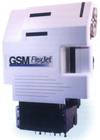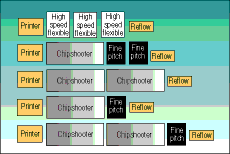
The marriage of a fine pitch placement machine and a chipshooter offers economic and productivity advantages.
There is a movement underway that could shape the way assembly lines look in the future. For years, speed and flexibility have been the essential metrics and determining factors used to purchase component placement equipment. Speed brings the typical chipshooter to mind, capable of fast small part placement, but suffering as component size and accuracy demands increase. Flexibility conjures up the image of a fine pitch machine accurately handling a wide range of parts, from chips to leaded components to advanced packages, at speeds generally slower than those of a chipshooter.
Because PCB assemblers need speed and flexibility, the 'traditional' surface mount line is usually equipped, out of necessity, with one or more chipshooters and at least one, if not more, fine pitch machines. Assembly lines then become mixed, made up of different classes of placement equipment that force manufacturers to participate in a balancing act, hoping to realise the highest utilisation from each individual machine. The true difficulty is in the attempt to achieve a balance over the entire line - across different machine classes - because it is practically impossible to allow each machine to perform at full utilisation simultaneously.
The strengths and weaknesses of the different classes of placement machines are not fully to blame for these problems. Board designs are a contributing factor. Each generation of products has a different ratio of passive to active devices. Current design trends result in PCBs packed with chips that can outnumber leaded fine pitch devices by staggering ratios - 50:1 and up. That ratio will change. Whether PCB designs have more active or passive components in the future is speculative, at best.
This uncertainty makes it difficult for assemblers to maintain control over their equipment's utilisation. Regardless of whether there is a higher or lower ratio of passive to active components, a bottleneck is likely to occur somewhere in the assembly line. It could develop as the chipshooter struggles to move a chip-heavy bottom-side board to a fine pitch machine downline. Conversely, if the ratio of chips to leaded components is small enough to move the PCB quickly past the chipshooter, the board may sit idle waiting for the fine pitch machine to complete its part of the job.
The problems associated with the 'traditional' assembly line are only magnified by shrinking profit margins and the hunt for competitive advantage. As consumer products become increasingly specialised, manufacturers find their assembly lines changing from one product to another more often. Product changeovers can require more than the changing of feeders and new software data. If it requires different placement heads for the new components, the line will be down at least while the heads are swapped. If the entire line needs to be reconfigured to reach an acceptable utilisation, downtime is multiplied.
The lines that were built to serve either low-mix, high-volume or high-mix, low-volume production environments simply will not address the needs of today's more common high-mix, high-volume manufacturing. The apparent solution is the creation of a new class of placement machine - one that handles the smallest chips to the largest, most advanced components with both accuracy and speed. If such a machine existed, the various machine classes responsible for component placement on the traditional surface mount assembly line could be replaced with a series of these identical 'high speed flexible' modules.

Overcoming obstacles in the road
Just as the concept of a chipshooter placing leaded components quickly creates a disconnect in the mind of the assembler, so does the idea of a fine pitch machine putting down large numbers of chips at high speed. The challenge to engineer a faster fine pitch machine is far more attainable than improving chipshooter accuracy for larger leaded devices. In addition, per unit of floorspace, a line comprised of bulky chipshooters is an uneconomical alternative to a line of smaller, modular placement machines with wide-ranging capabilities.
The benefits of a line made up of multiple 'high speed flexible' modules would have an immediate impact on assemblers. For instance, since each module could place the full range of component types, line balancing and optimisation would no longer be directly dependent on where the chipshooter and fine pitch machines were located. Application engineers could develop placement strategies well beyond the upstream/downstream limitations of traditional lines. In fact, the number of possible placement schemes would grow exponentially as the number of identical modules increased. And, since every machine in the line is alike, it becomes impossible for them to be in the wrong place or incorrect order for a given application. The new challenge is to find the best way to spread the work over all the modules. As the modular line becomes more common, the library of supporting optimisation software developed by equipment manufacturers would essentially eliminate much of this work.
The threat to making this concept a reality is that many fine pitch machine designs do not place chips at speeds adequate to lead PCB manufacturers away from their allegiance to the chipshooter. Whether it is a turret-style, revolver or massively parallel system, chipshooters are fast when it comes to placing chips. To bridge the gap, certain improvements need to be made to the fine pitch machines. Increasing the number of spindles on a placement head would certainly help, as would increasing the speed of the positioning and board handling systems. In addition, if vision capabilities were resident directly on the placement head, nonvalue added steps like moves to an upward-looking camera could be eliminated. All of these increase the time a machine can devote to placement. They also are all in the realm of possibility for standard fine pitch machines, and if implemented, would increase performance.
Nevertheless, even with these enhancements, a single high-speed flexible module, by itself, will not stand up to the chipshooter's pure speed for small parts. That is why it is critically important to understand that for this concept to take hold, multiple high-speed flexible modules need to work in tandem. If you could reach chip placement speeds of 20 000 to 30 000 cph per high-speed flexible machine, then two modules side-by-side could offer throughput that meets, even exceeds, that of a chipshooter. And, since the footprint of the high-speed flexible module falls generally between one-third to one-half the size of the standard chipshooter, the multiple module concept can achieve levels of speed and flexibility necessary to warrant serious consideration.
In addition to these benefits, other residual advantages of the truly modular plalcement solution become clear. Only one software package (including programming, set-up, optimisation and balancing) would need to be learned with only one user interface. Further, operator training is uncomplicated, because all the operator needs to learn is one placement machine across the line. Machine maintenance would be simplified. And, regardless of the number of high-speed flexible modules, there is only one set of supporting documentation. There would be only one set of feeders necessary to maintain, and only one company to deal with for spare parts and service.

Driving forward
Because component trends are marked with uncertainty, machines that handle a variety of parts and applications represent money wisely invested in the future. The ratio of passive to active components will almost certainly change, but whether it increases or decreases remains unclear. A camp is developing toward on-chip integration. Leaded fine pitch devices are widely used today, but array packages are gaining momentum. These trends, or rather the uncertainty of which trends will emerge as the norm, make capital equipment acquisition more difficult and formidable than it ever has been before. The line purchased today may possibly be inadequate for tomorrow's designs.
In fact, every time an assembler accepts any piece of dedicated placement equipment, the possibility exists that the amortisation used to justify the purchase will outlive the usefulness of the machine. This is driving the push toward developing a single machine with wider capabilities. Chipshooters are among the most expensive pieces of assembly equipment. Manufacturers have been willing to pay the price to gain the speed advantages over a limited component range, mainly because that range matched the most common component type - the chip. But as PCB designs continue to change, some fear the high-priced chipshooter will become the most underutilised piece of equipment in the line.
The high-speed flexible solution should be less cost-prohibitive than the traditional equipment scenario. Machine pricing could be more in line with that of the fine pitch machine, while taking away some of the 'sting' experienced every time a piece of dedicated equipment is bought. When those costs are weighed against the added product flexibility, decreased machine downtime and simplified programming, maintenance and set-up of the modular line, an economy of scale develops which may require an entry cost, but provides long-term benefits that outweigh the investment due to the reasons previously mentioned.
Conclusion
The movement toward modular assembly lines is gaining momentum. A battle of positioning and posturing is underway to set the definitions and expectations of the new class of machines. Whether it is ultimately referred to as a 'high-speed flexible' machine, a 'modular' machine, or some other term is unimportant. What will matter is that the machine presents real solutions to the problems experienced by PCB assemblers, especially those stemming from the critical need to rapidly adapt to changes in the production environment. If the development of truly modular placement machines is to become widely accepted, equipment manufacturers should all begin with a concept grounded in the very definition of modular: constructed with standardised units or dimensions for flexibility and variety in use.
Therefore, an assembly line solution that involves more than one type of placement machine does not meet the criteria necessary to call it 'modular'. The line balancing, optimisation and set-up problems that are alleviated by a true modular placement solution still exist when a particular line is made up of hybrid machines. There is no question: mixed assembly systems have served the industry well and in the absence of an improved technology, would continue regardless of the issues present on today's floor.
Since the technology exists, however, that allows both chip and fine pitch placement at high speeds on a single machine, we can expect to see a continuing emergence of the high-speed flexible module. The widespread release of these machines will mark a new era in component placement, with higher machine, line and plant utilisation levels as the result. The apparent development of modular placement machines by equipment manufacturers - each capable of handling the wide spectrum of surface mount applications - is proof that the concerns, and moreover, the frustrations sounded by the participants in PCB assembly have not gone unanswered.
| Tel: | +27 11 609 1244 |
| Email: | [email protected] |
| www: | www.zetech.co.za |
| Articles: | More information and articles about ZETECH ONE |

© Technews Publishing (Pty) Ltd | All Rights Reserved